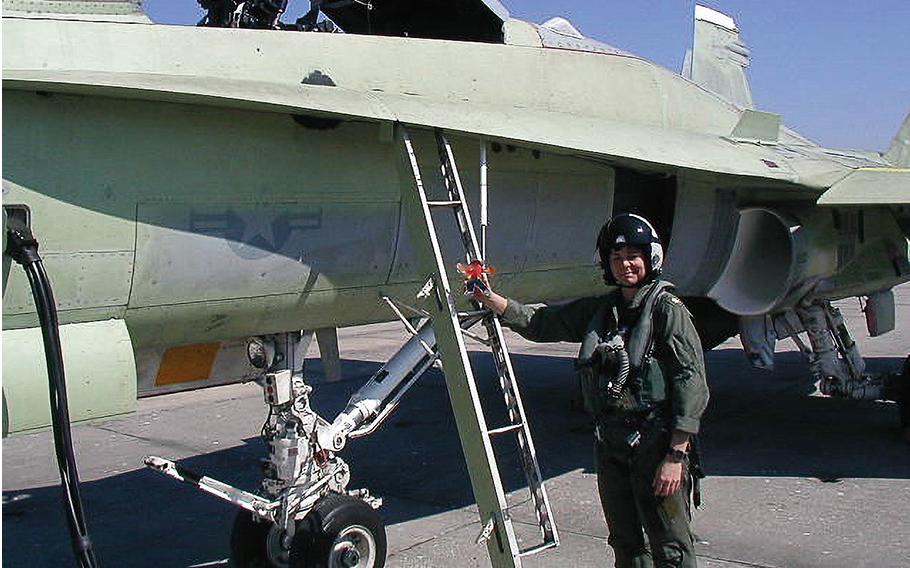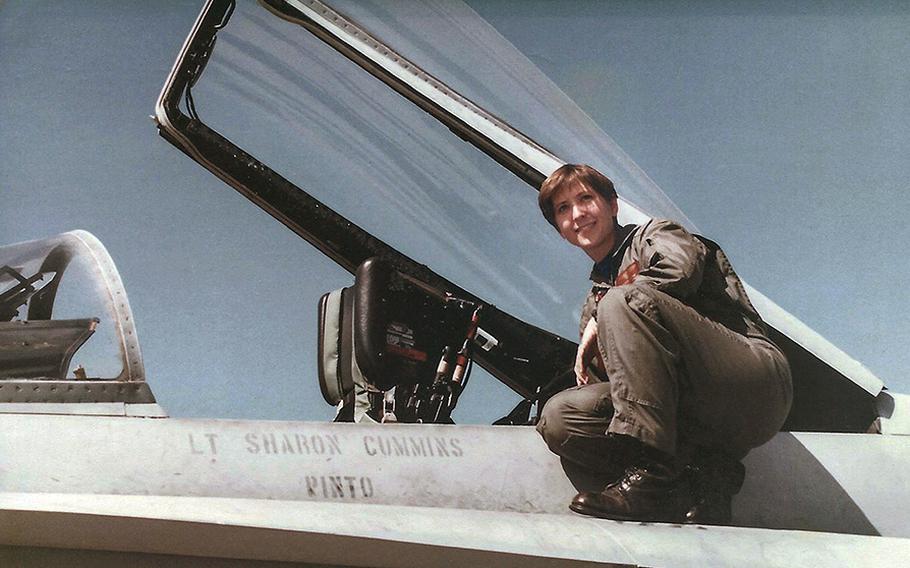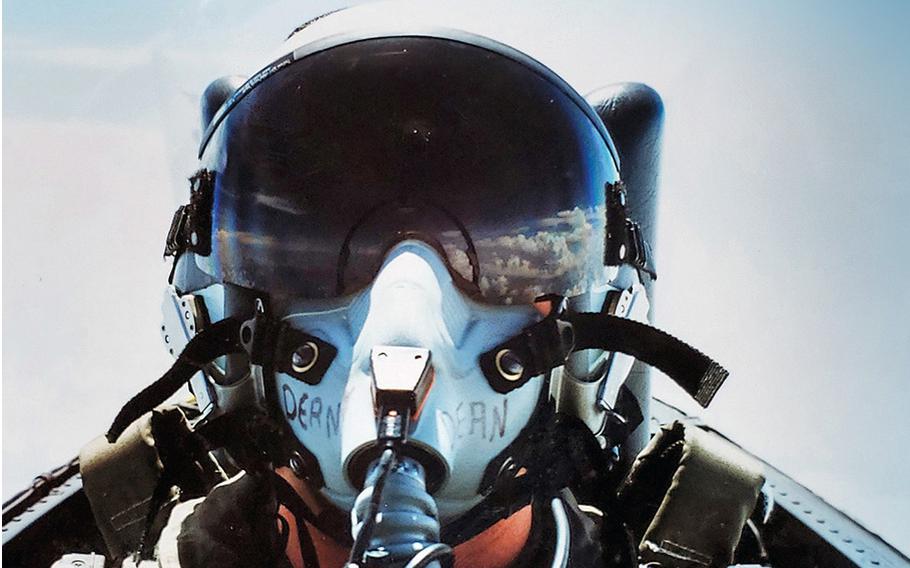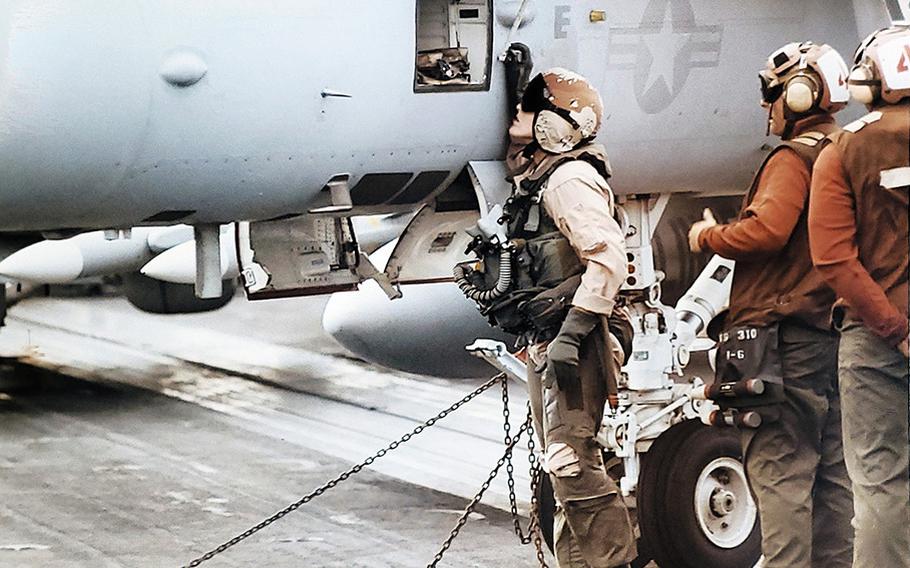
Kim Dyson prepares to fly a functional check flight in an aircraft that has just had its center section replaced. On Nov. 15, 1994, Dyson quietly made history when she became the first female pilot to fly an official combat mission for the U.S. military. (Kim Dyson/Smithsonian National Air and Space Museum)
On Nov. 15, 1994, Navy Lt. Kimberly “Face” Dyson quietly made history when she became the first female pilot to fly an official combat mission for the U.S. military. No one would know her name until nearly 30 years later.
The Smithsonian’s National Air and Space Museum revealed the names of the first five female military pilots to fly combat missions in an article written by museum curator Michael Hankins in the Dec. 21 issue of its magazine Air & Space Quarterly.
Dyson took off from the deck of the USS Dwight D. Eisenhower in an F/A-18C Hornet during Operation Southern Watch, a U.S. effort to enforce no-fly and no-drive zones in Iraq following the 1991 Gulf War. Her fellow F/A-18C pilots Lt. Sharon “Pinto” Deegan (Cummins at the time) and Lt. j.g. Joy “Trigger” Dean (Adams at the time); Grumman E-2C Hawkeye pilot Lt. Lisa “KP” Kirkpatrick; and Sikorsky SH-3 helicopter pilot Lt. Lynne Fowler would fly missions in 1994 and 1995 for Southern Watch and Operation Deny Flight, enforcing U.N.-sanctioned no-fly zones over Bosnia and Herzegovina following the breakup of Yugoslavia.

Sharon Deegan’s desire to fly jet aircraft motivated her to join the Navy. (National Archives and Records Administration)
“We were ready to do anything,” Dyson said in the Air & Space Quarterly article. “It was a little nerve-racking. But in the end, it turned out to be a normal flight, very much the same as we had done in practice.”
The article is titled “Just Doing Their Jobs,” and it’s an accurate reflection of the women’s attitudes toward their missions at the time. The pilots preferred “to be recognized for what they did, not who they were,” the article states.
“I mean, it’s 30 years later, and we’re just now kind of talking about it,” Dean said in the article. “The fact that we did it, and did it without a lot of fanfare, speaks volumes. It really set the precedent for any future integrated deployments.”

Three of the first American women to fly combat missions — including Joy Dean — were Hornet pilots. (Joy Dean/Smithsonian National Air and Space Museum)
“I didn’t feel any weight of history,” Dean continued. “I wanted to be judged on my merit, and if I was judged on my merit, then we’d be good to go. And we were.”
The pilots reached out to Hankins and the Smithsonian last year, and Dyson, Deegan, Deen and Kirkpatrick sat for phone interviews in May. Hankins said he isn’t sure why the pilots chose to wait until now to reveal themselves. (The pilots declined to be interviewed by Stars and Stripes.)
“I don’t know what their motivations were; from my perspective, they contacted me themselves out of the blue one day and were like, ‘Who does the Smithsonian give credit to for this [the first female-flown combat missions]?’ “ Hankins said. “I was like, ‘No one, officially; here’s what I know about the history,’ and they were like, ‘Oh, well I think it might be us.’ And then we started talking about their careers, and they showed me their log books, and they showed me some of their documentation. And I started digging into archives and contacting the Navy, and it just all fell into place.”
In April 1993, then-Defense Secretary Les Aspin ordered the military services to allow women to fly combat missions and to be assigned to Navy combat ships. The Eisenhower became the first aircraft carrier to deploy with female sailors on board.
Other firsts for female pilots have been widely reported: A-10 Thunderbolt pilot Col. Martha McSally in 1995 became the first woman to fly combat missions for the U.S. Air Force; Navy Lt. Kara Hultgreen was the first female carrier-based fighter pilot for the Navy (and tragically became the first female fighter pilot to die in a crash on Oct. 25, 1994); and Navy Lt. Kendra “Yukon” Bowers (then Williams) was the first female fighter pilot to drop bombs on a target, in Iraq in 1998.
Dyson’s achievement was touched on in newspapers and journalist Jean Zimmerman’s 1995 book “Tailspin,” though she and her fellow pilots aboard the Eisenhower were not named.
“[There was] that sense of almost being happy that they weren’t more famous — that kind of sense of, ‘We did the job, we were judged by how well we did the job that we had and we did it well and everybody recognized that, and that’s all we really ever wanted,’ “ Hankins said of his interviews with the pilots. “I think that really spoke to me, and that’s why I chose to make that the central point of the article.”

Joy Dean conducts a preflight inspection of her F/A-18C prior to launching on her first strike mission in support of Operation Southern Watch over Iraq. (Charles Beaudin/Smithsonian National Air and Space Museum)